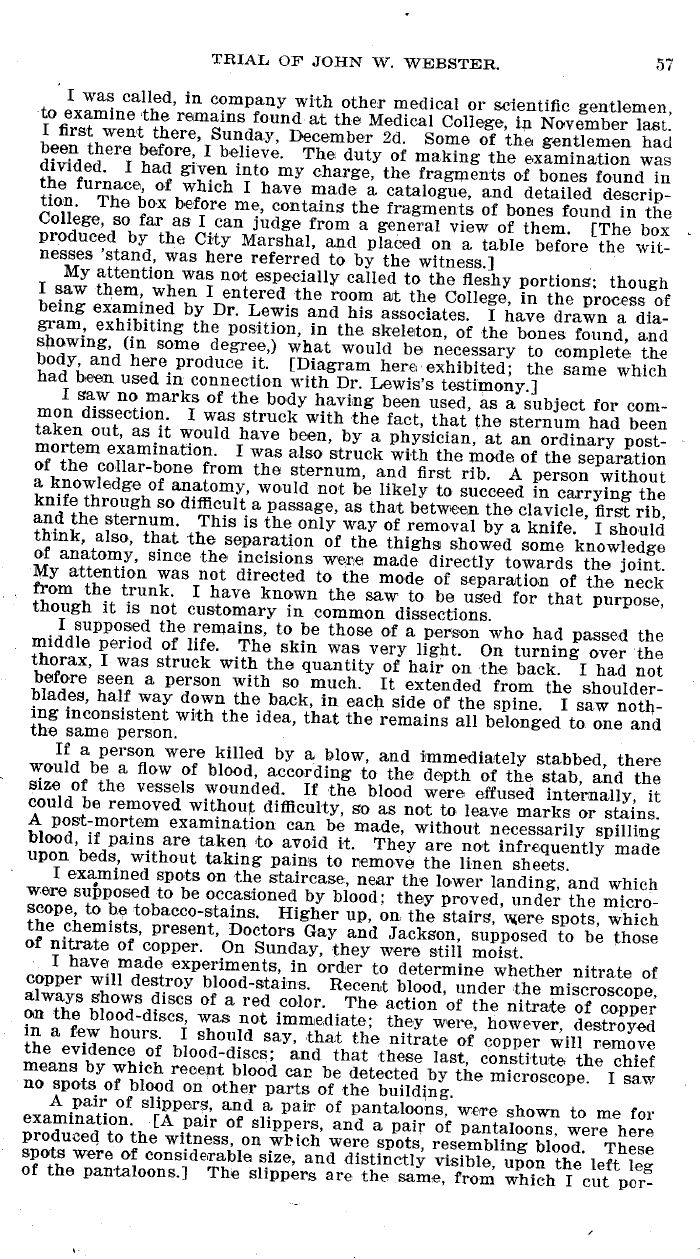|
TRIAL OF JOHN W. WEBSTER.
I was called, in company with other medical or scientific gentlemen,
to examine the remains found at the Medical College, in November last.
I first went there, Sunday, December 2d. Some of the gentlemen had
been there before, I believe. The duty of making the examination was
divided. I had given into my charge, the fragments of bones found in
the furnace of which I have made a catalogue, and detailed descrip-
tion. The box before me, contains the fragments of bones found in the
College, so far as I can judge from a general view of them. [The box
produced by the City Marshal and placed on a table before the wit-
nesses 'stand, was here referred to by the witness.]
My attention was not especially called to the fleshy portions; though
I saw them, when I entered the room at the College, in the process of
being examined by Dr. Lewis and his associates. I have drawn a dia-
gram, exhibiting the position, in the skeleton, of the bones found, and
showing, (in so-me degree,) what would be necessary to complete the
body, and here produce it. [Diagram here exhibited; the same which
had been used in connection with Dr. Lewis's testimony.]
I saw no marks of the body having been used, as a subject for com-
mon dissection. I was struck with the fact, that the sternum had been
taken out, as it would have been, by a physician, at an ordinary post-
mortem examination. I was also struck with the mode of the separation
of the collar-bone from the sternum, and first rib. A person without
a knowledge of anatomy, would not be likely to succeed in carrying the
knife through so difficult a passage, as that between the clavicle, first
rib,
and the sternum. This is the only way of removal by a knife. I should
think, also, that the separation of the thighs showed some knowledge
of anatomy, since the incisions were made directly towards the joint.
My attention was not directed to the mode of separation of the neck
from the trunk. I have known the saw to be used for that purpose,
though it is not customary in common dissections.
I supposed the remains, to be those of a person who had passed the
middle period of life. The skin was very light. On turning over the
thorax, I was struck with the quantity of hair on the back. I had not
before seen a person with so much. It extended from the shoulder-
blades, half way down the back in each side of the spine. I saw noth-
ing inconsistent with the idea, that the remains all belonged to one and
the same person.
If a person were killed by a blow, and immediately stabbed, there
would be a flow of blood, according to the depth of the stab, and the
size of the vessels wounded. If the blood were effused internally, it
could be removed without difficulty, so as not to leave marks or stains.
A post-mortem examination can be made, without necessarily spilling
blood, if pains are taken -to avoid it. They are not infrequently made
upon beds, without taking pains to remove the linen sheets.
I examined spots on the staircase near the lower landing, and which
were supposed to be occasioned by blood; they proved, under the micro-
scope to be tobacco-stains. Higher up, on the stairs, Aere spots, which
the chemists, present, Doctors Gay and Jackson, supposed to be those
of nitrate of copper. On Sunday, they were still moist.
I have made experiments, in order to determine whether nitrate of
copper will destroy blood-stains. Recent blood, under the miscroscope,
always shows discs of a red color. The action of the nitrate of copper
on the blood-discs was not immediate; they were, however, destroyed
in a few hours. I should say, that the nitrate of copper will remove
the evidence of blood-discs; and that these last, constitute the chief
means by which recent blood car be detected by the microscope. I saw
no spots of blood on other parts of the building.
A pair of slippers, and a pair of pantaloons, were shown to me for
examination. [A pair of slippers, and a pair of pantaloons, were here
produced to the witness on which were spots, resembling blood. These
spots were of considerable size, and distinctly visible ,
of the pantaloons.] The
e upon the left leg
slippers are the same, from which I cut per-
|

